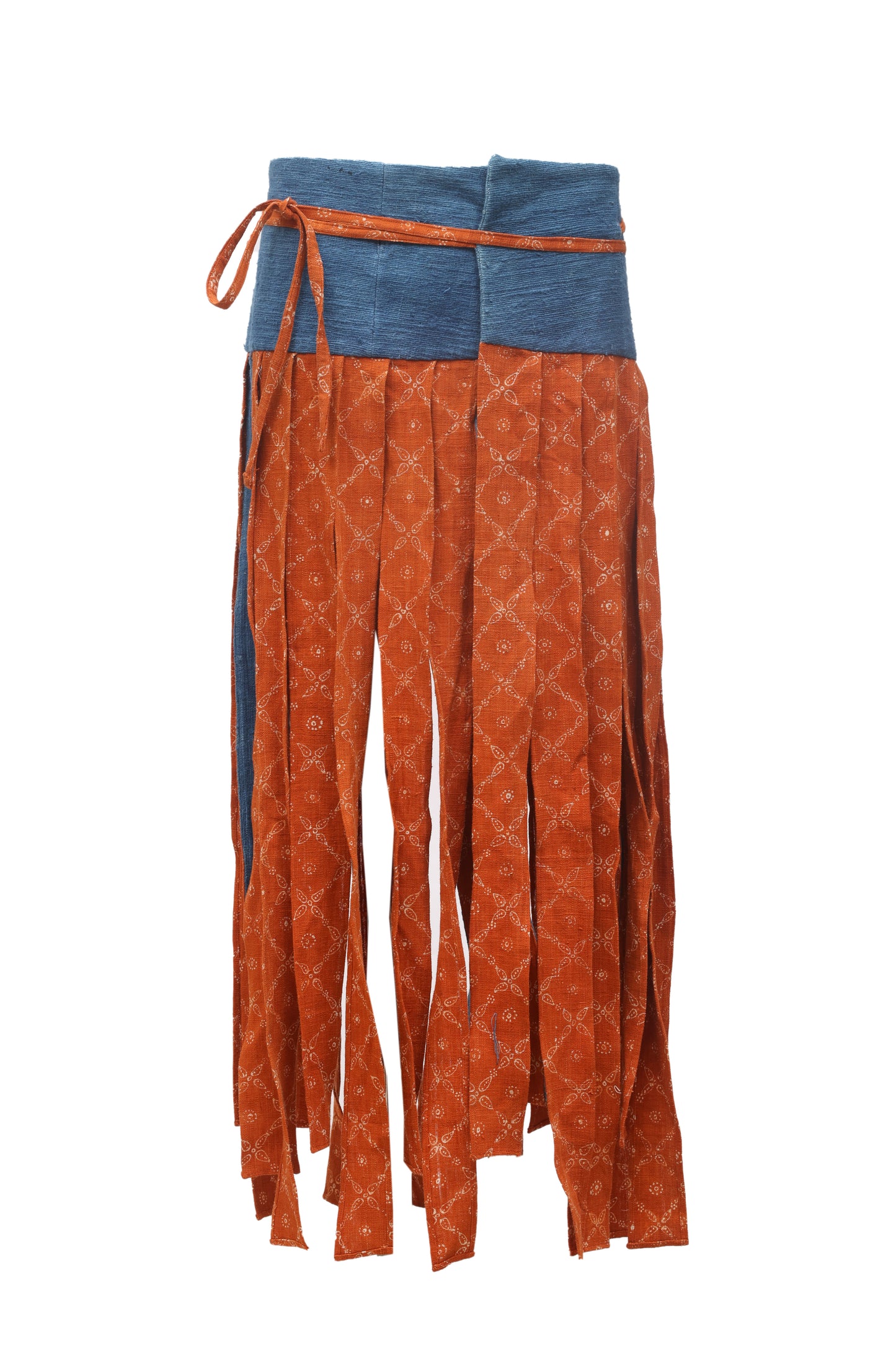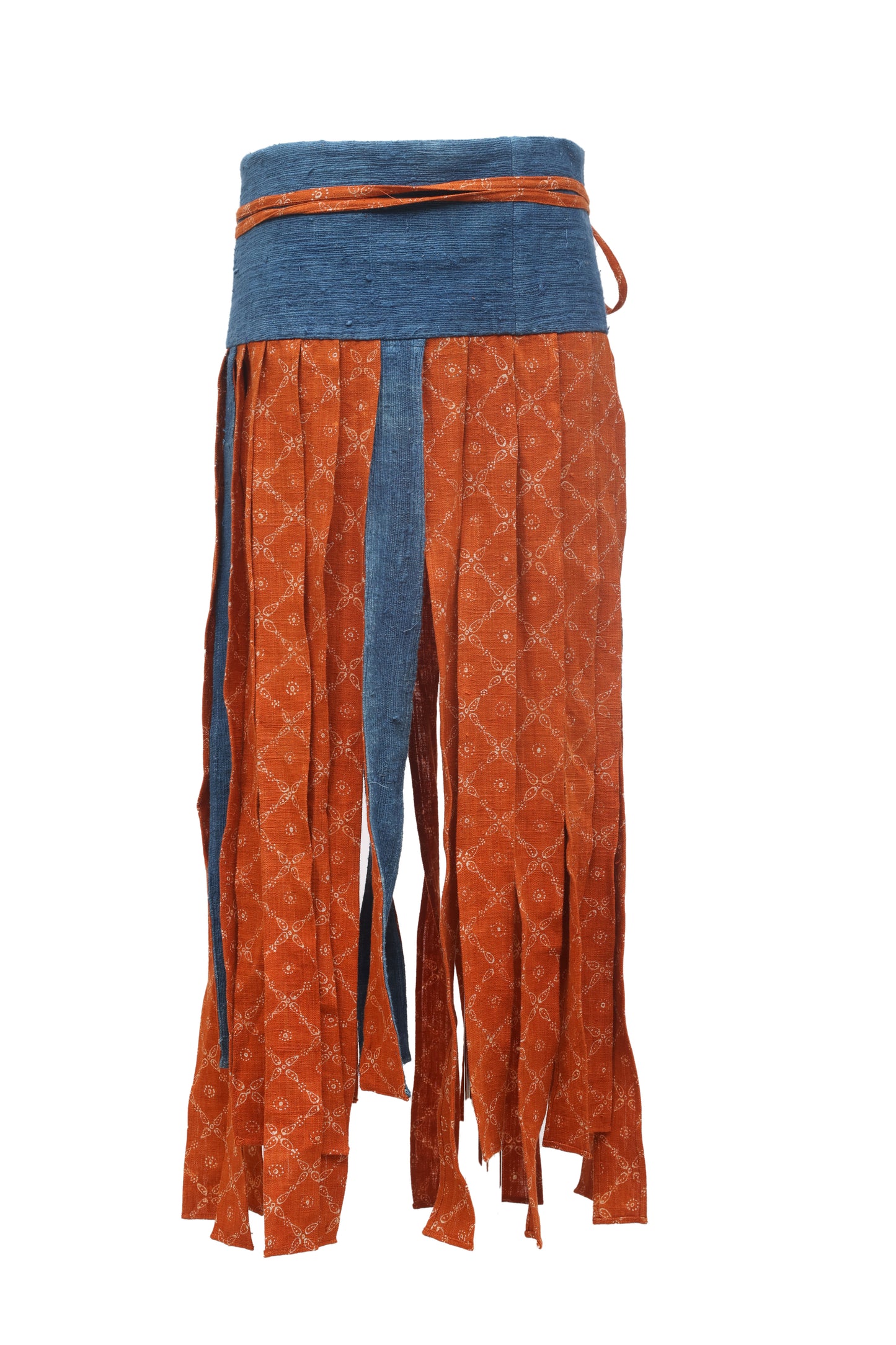IGANU.003
Iganu is a unique piece crafted from vintage double sided indigo batik from Solo, Java and handwoven vintage indigo cotton from Japan. This one-of-a kind garment can be worn as a belt over any other clothes- a dress, jeans, pants or as a skirt on its own.
Batik is an Indonesian technique of wax-resist dyeing applied to the whole cloth, that originated in Java, Indonesia. This method of dyeing in which patterned areas are covered with wax so they will not receive the colour. The method is used mainly on cottons and in the traditional colours of blue, brown, and red. Multicoloured and blended effects are obtained by repeating the dyeing process several times, with the initial pattern of wax boiled off and another design applied before redyeing. In Java, by the mid-18th century, a small copper crucible with a handle and narrow applicator spout for applying the wax came into use, producing a much more elaborately patterned cloth; a further Javanese innovation was the wood-block wax applicator introduced in the 19th century.
Indigo was probably introduced to Japan from southern China sometime soon after the fifth century.The oldest evidence of indigo dyeing in Japan dates back to the 10th century. In Japanese, indigo dyeing is known as AI-ZOME. The plants can grow about two and a half feet high. Their stems are green or almost red, and their large leaves are green, but turn dark blue when dried.
In Japan polygonum or tade, is used in the natural indigo dye process. The oldest evidence of indigo dyeing in Japan dates back to the 10th century.
The first ai-zome textiles came to Japan from Southeast Asia. A number of indigo textiles can be found in the 8th century treasure trove in Nara’s Shoso-in Repository (part of Todai-ji Temple). Japanese ai-zome dyeing has its roots in the Heian period (794-1185). By the Kamakura period (1192-1333) the Japanese method was well established.
Japanese ai-zome culture exploded in the Edo period (1600-1868) when laws were passed preventing the lower classes from wearing silk and cotton became the popular alternative. In addition to being readily available (the indigo plant is native to Japan), ai-zome was also color fast on cotton and thus faded slowly, adding to its appeal.
There are five basic materials used in Japanese indigo dyeing: sukumo (the tade leaves of the Japanese indigo plant), fusuma (wheat bran), sake, hardwood ash, and lime.
Ai-zome dyeing is a very complicated and long process. The chemical compound indican contained in the raw leaves is converted into indigo by fermenting the leaves. The traditional process uses only natural materials and no chemicals of any kind. When the fermented indigo solution is ready the cloth is repeatedly soaked in the vat. After squeezing the excess liquid from the textile it is spread wide and hung on a rope. This allows the textile to oxidize and thus fix the color. Just after the textile is removed from the vat it looks dark green. As it oxidizes it turns blue. The soaking and oxidizing steps are repeated over and over until the final desired color has been produced. For the darkest blues soaking lasts 30 minutes and is repeated 30 to 40 times.
Keynote from Karatoyaa:
• Please note, that due to antique nature of the fabrics there may be signs of past experiences - we believe it adds value and a meaning to the garments.
• Some naturally dyed fabrics even after lasting generations may leave colour
• Please keep in mind that all Karatoyaa pieces are Dry Clean only with the Professional service provider.
Couldn't load pickup availability
DETAILS
DETAILS
Iganu are one-of-a-kind belt like pieces crafted from numerous stripes, mostly created from leftovers and trimmings.
COMPOSITION
COMPOSITION
UPCYCLED COTTON
SIZE & FIT
SIZE & FIT
ONESIZE
LENGTH 104 cm
WAIST 75-106 cm
CARE
CARE
TO BE TREATED WITH LOVE AND CLEANED AT PROFESSIONAL DRY CLEANER ONLY
Share




